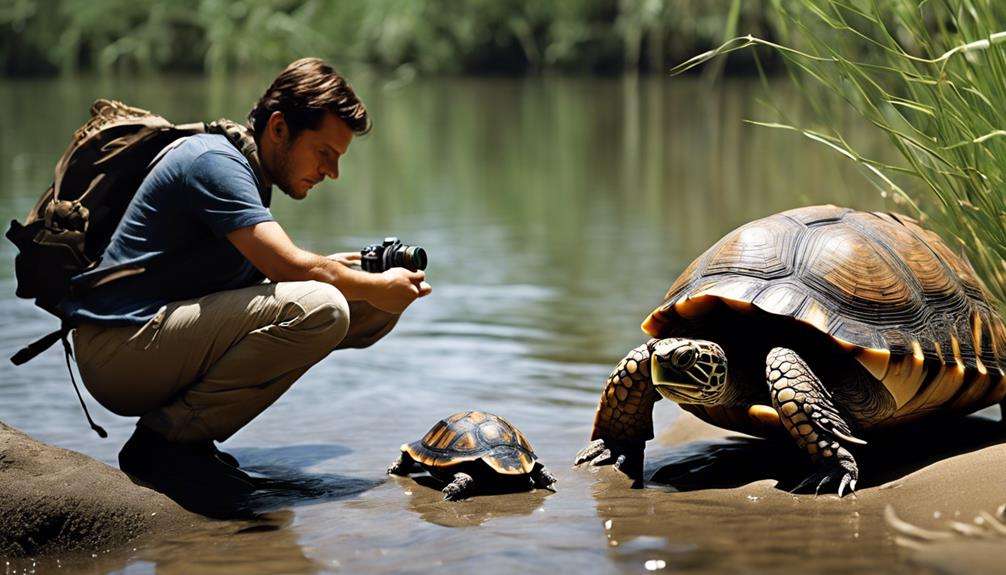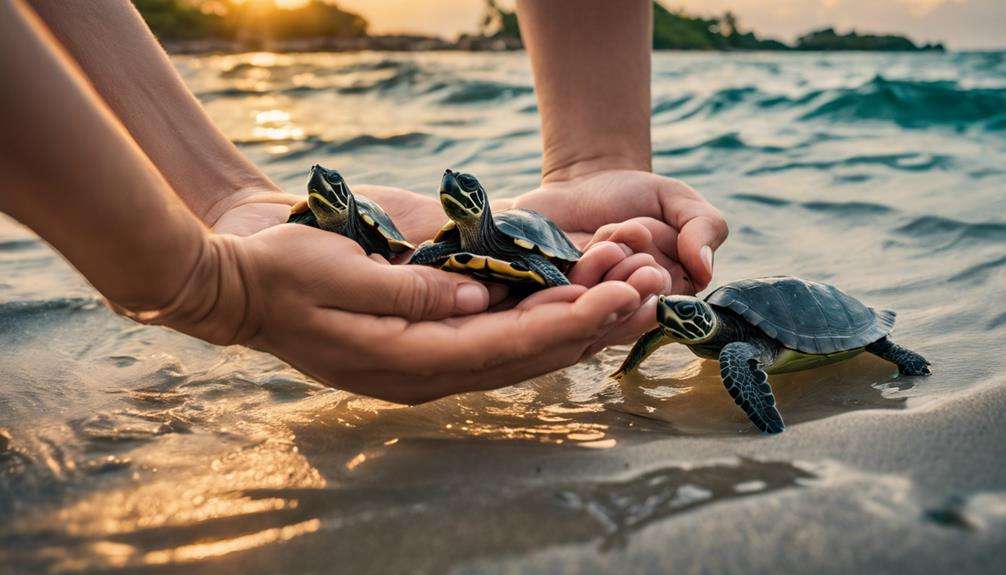When pondering the pressing issue of protecting endangered turtle habitats, ponder this: the precarious plight of these peaceful creatures holds profound implications for our planet's delicate ecosystems. Understanding the intricate interplay between sea turtles and their surroundings is essential for grasping the urgency of conservation efforts.
But why does safeguarding these habitats truly matter in the grand scheme of environmental preservation? Let's unravel the critical reasons behind the imperative need to safeguard the safety and longevity of these unique turtle habitats.
Key Takeaways
- Rare turtles play a crucial role in biodiversity and ecosystem balance.
- Habitat destruction, pollution, and climate change threaten turtle survival.
- Conservation efforts focus on habitat restoration and community engagement.
- Protecting turtle habitats is vital for preserving biodiversity and ecosystem health.
The Role of Rare Turtles in Ecosystems
Rare turtles play important roles in ecosystems by contributing to biodiversity and maintaining ecological balance through their unique behaviors and interactions with other organisms. In marine habitats, endangered turtles like the Kemp's ridley turtle help regulate crab populations, preventing overgrazing of seagrass beds and maintaining the overall health of the ecosystem. These turtles act as critical links in the food chain, controlling the populations of their prey species and preventing unchecked growth that could disrupt the delicate balance of marine habitats. Additionally, rare turtles such as the flatback turtle play a significant role in maintaining biodiversity by consuming a variety of organisms, preventing any one species from dominating the ecosystem.
Conservation efforts focused on protecting the habitats of endangered turtles are essential to safeguarding the ecological balance of marine ecosystems. By preserving these habitats, we can guarantee that rare turtles continue to fulfill their unique roles in maintaining biodiversity and sustaining the health of marine environments for generations to come.
Threats to Unique Turtle Habitats
The preservation of unique turtle habitats faces a multitude of threats that jeopardize the delicate ecosystems essential for their survival. Destruction of nesting beaches due to coastal development not only reduces available nesting sites but also disrupts the natural processes vital for turtle reproduction. Pollution from urban runoff and industrial activities introduces harmful substances into these habitats, affecting water quality and overall ecosystem health. Additionally, climate change impacts such as rising sea levels and extreme weather events pose a significant threat, altering nesting areas and affecting the survival rates of turtle hatchlings.
Invasive species introduced to nesting areas can outcompete native species for resources, disrupt nesting behaviors, and even prey on turtle eggs and hatchlings. Also, overfishing and destructive fishing practices in marine habitats can lead to the depletion of crucial food sources for turtles, impacting their growth and reproductive success. Addressing these threats through targeted conservation efforts and sustainable management practices is essential to safeguarding the future of unique turtle habitats.
Conservation Efforts for Endangered Turtles
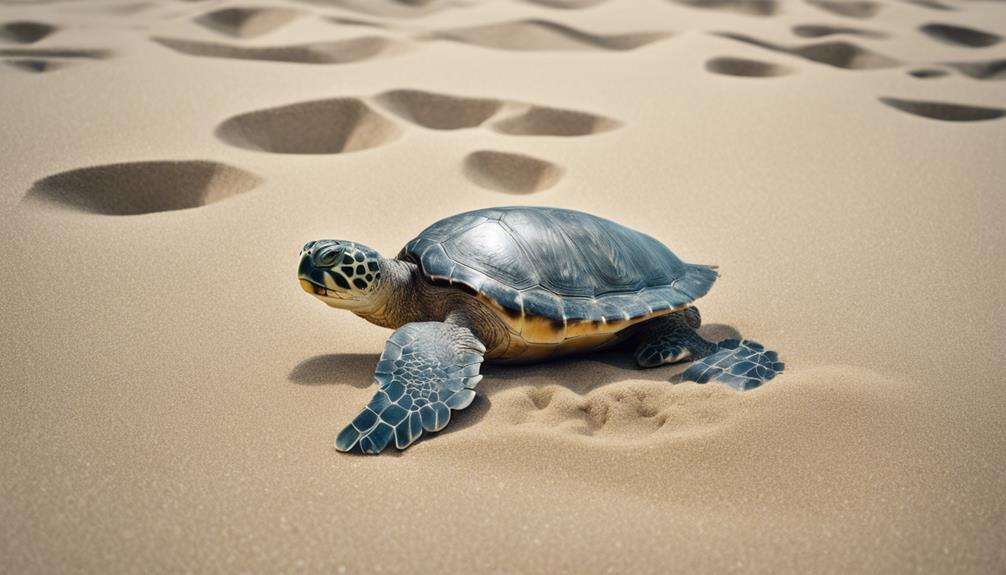
To enhance the conservation of endangered turtles, habitat restoration projects are important to revive degraded habitats and create suitable environments for these species.
Community engagement initiatives play a significant role in raising awareness, garnering support, and implementing sustainable conservation practices to protect turtle habitats effectively.
Habitat Restoration Projects
Enhancing degraded habitats important for endangered turtle species through targeted restoration projects is essential for their survival and population recovery. Habitat restoration projects specifically focus on improving nesting sites, feeding grounds, and migration routes for endangered turtles like the green sea turtles.
These initiatives involve activities such as planting native vegetation, removing invasive species, and reducing pollution levels in turtle habitats. By restoring these habitats, a more suitable environment is created for endangered turtles to thrive and reproduce successfully.
Successful habitat restoration projects have the potential to not only increase population numbers but also enhance the genetic diversity of endangered turtle species. Therefore, investing in habitat restoration is critical for the long-term conservation of these vulnerable marine creatures.
Community Engagement Initiatives
Engaging local communities in conservation efforts for endangered turtles involves fostering awareness and active participation in habitat protection initiatives. Community engagement initiatives play an important role in safeguarding endangered turtle habitats by involving residents and organizations in collaborative efforts.
These initiatives focus on raising awareness about the significance of preserving turtle habitats and the threats faced by these species. Community members contribute to habitat restoration projects, creating suitable environments for endangered turtles to thrive. Educational programs and outreach events are organized to inform the public about the importance of habitat conservation.
Through these collective actions, the long-term survival of endangered turtle species is guaranteed, highlighting the essential role of community engagement in protecting these crucial ecosystems.
Impact of Habitat Destruction on Rare Turtles
How does habitat destruction directly impact the survival of rare turtles?
Habitat destruction poses a significant threat to rare turtles by leading to the loss of important nesting sites. These sites are essential for their breeding success, and their destruction can result in a decline in population numbers.
Additionally, coastal habitat destruction disrupts the natural migration and foraging patterns of endangered turtles, further endangering their survival.
Pollution stemming from habitat destruction introduces harmful substances such as plastics and chemicals into the turtles' environments. This pollution can have detrimental effects on rare turtles, as they may inadvertently ingest these substances while foraging.
Rare turtles rely on specific habitats for feeding, resting, and nesting, making habitat destruction a critical issue that directly impacts their well-being.
To safeguard the long-term survival and population recovery of rare turtles, it's imperative to prioritize the preservation and restoration of their habitats.
Significance of Preserving Exotic Turtle Habitats
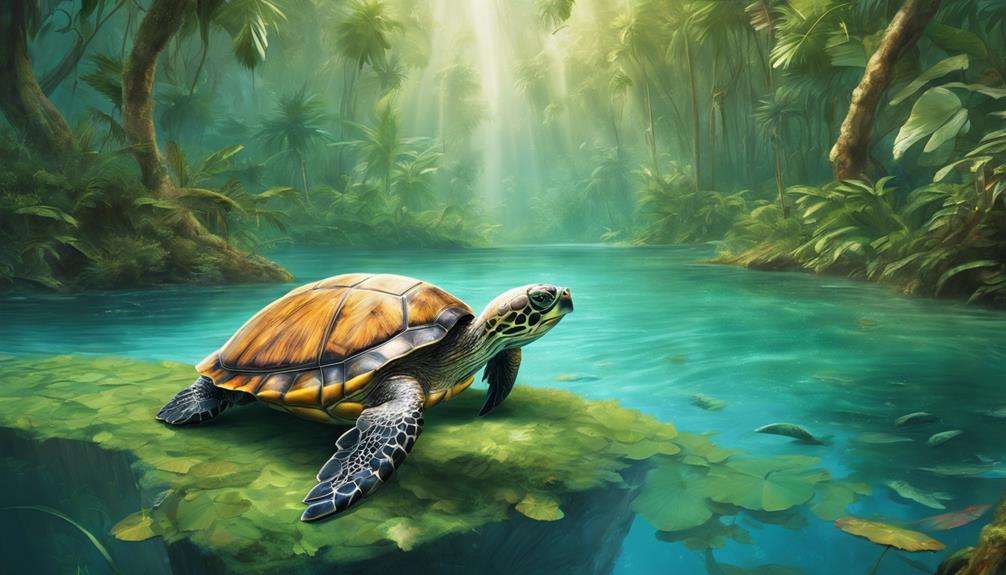
Preserving exotic turtle habitats is essential for maintaining habitat diversity and ecosystem balance. These habitats play a significant role in supporting unique ecosystems and preserving biodiversity.
Destruction of these habitats can have far-reaching consequences on rare species and ecosystem functions.
Habitat Diversity Importance
Protecting exotic turtle habitats is essential for the preservation of specialized species and the overall health of ecosystems. These unique habitats play a vital role in maintaining biodiversity and ecosystem balance.
Specialized turtle species rely on these environments, which often provide critical nesting sites and support rare plant species. Endangered turtle habitats are particularly important as they house species at risk of extinction.
Loss of these habitats not only threatens the survival of specialized turtles but also disrupts the delicate balance of ecosystems. By safeguarding diverse turtle habitats, we contribute to the resilience and vitality of ecosystems, ensuring the continued existence of these specialized species and promoting overall ecosystem health.
Ecosystem Balance Preservation
The preservation of exotic turtle habitats is essential for maintaining ecosystem balance and biodiversity, supporting unique species, and contributing to overall ecosystem health. Endangered turtle habitats play a critical role in the intricate web of marine ecosystems. These habitats harbor diverse species, including sea turtles, whose survival is dependent on the conservation of their unique environments.
Disturbances or loss of these habitats can have cascading effects on other species and ecosystem functions, disrupting the delicate balance that sustains marine biodiversity. Conservation efforts focused on preserving endangered turtle habitats not only safeguard these iconic species but also have far-reaching benefits for marine ecosystems as a whole. By safeguarding these habitats, we can guarantee the preservation of biodiversity and the health of our oceans.
Ecological Importance of Rare Turtle Habitats
Rare turtle habitats host specialized plant and animal species that contribute to unique and diverse ecosystems. These habitats are vital for maintaining high biodiversity levels, as their distinct environmental conditions provide a home for a variety of rare and endangered species. By conserving these habitats, we not only protect the endangered turtle populations that rely on them but also safeguard the entire ecosystem's balance and resilience.
The ecological importance of rare turtle habitats can't be overstated. These habitats act as havens for plants and animals that have adapted specifically to their surroundings, creating a delicate web of interdependence. When these habitats are disturbed or destroyed, it can have cascading effects on the entire ecosystem, leading to loss of biodiversity and ecosystem services.
Preserving rare turtle habitats isn't just about protecting one species; it's about safeguarding an entire intricate system that supports life. Conservation efforts focused on these habitats are vital for ensuring the long-term survival of endangered turtles and the preservation of our planet's biodiversity.
Human Activities Affecting Turtle Habitats
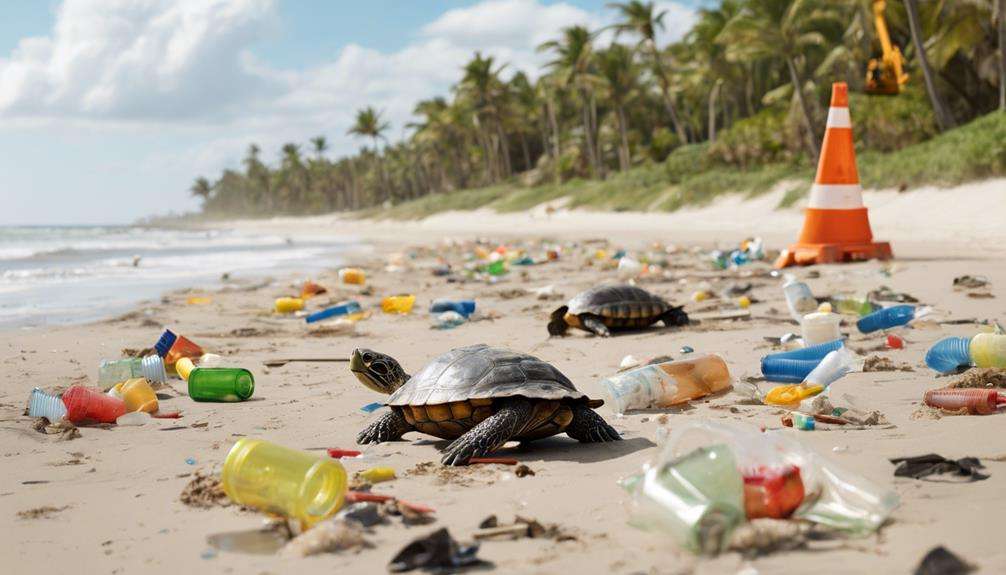
Human activities have a significant impact on turtle habitats, with coastal development, pollution, and climate change being key factors influencing the survival of these endangered species. Coastal development leads to the destruction of nesting beaches and coastal vegetation, reducing suitable nesting sites for turtles.
Pollution, including oil spills and marine debris, poses serious threats to turtle habitats and marine ecosystems. Climate change exacerbates these challenges, with rising temperatures affecting nesting success and sea level rise eroding nesting areas. Light pollution disrupts nesting behavior and the orientation of hatchlings towards the ocean, further endangering turtle populations.
Habitat degradation from tourism activities and beachfront construction also threatens turtle survival by reducing available nesting sites. To protect these habitats, it's imperative to implement measures that mitigate the impacts of coastal development, pollution, and climate change, safeguarding nesting beaches and reducing habitat degradation.
Benefits of Protecting Endangered Turtle Habitats
Preserving endangered turtle habitats is important for maintaining biodiversity and ensuring the survival of these essential marine ecosystems. By protecting these habitats, we safeguard critical nesting and foraging grounds for various turtle species, which in turn helps in preserving biodiversity.
Healthy turtle habitats aren't only vital for the survival of endangered turtles but also play a significant role in maintaining the overall health of marine ecosystems. Additionally, conservation efforts contribute to the local economy through activities like ecotourism and sustainable fishing practices that rely on balanced marine ecosystems.
Furthermore, the conservation of endangered turtle habitats is essential for mitigating the impacts of climate change and preserving coastal resilience. By prioritizing the protection of these habitats, we can uphold cultural and spiritual connections to turtles, fostering environmental stewardship within communities and ensuring a sustainable future for both marine life and human well-being.
Global Initiatives to Save Rare Turtle Habitats
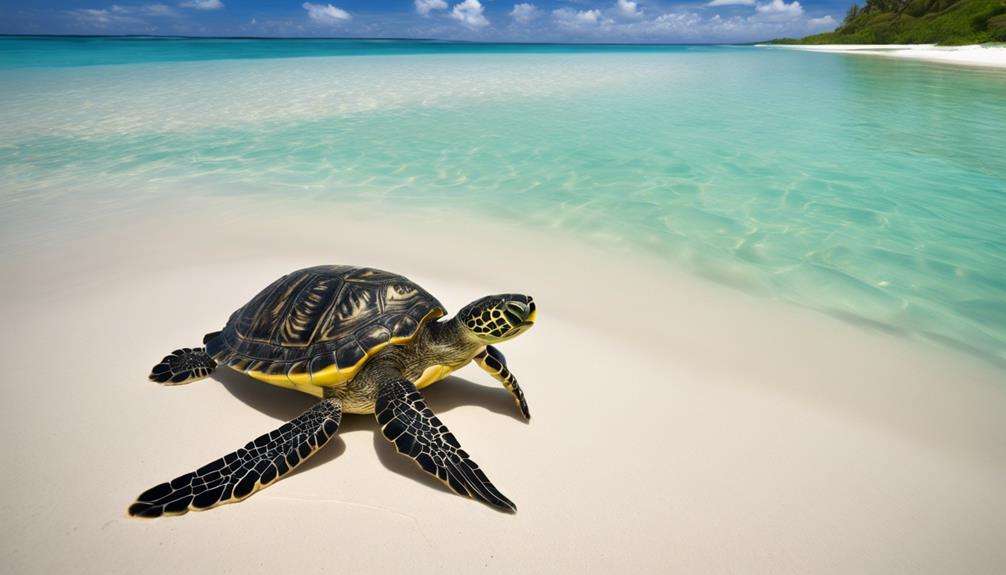
Implementing conservation strategies to safeguard endangered turtle habitats globally is essential for the preservation of marine biodiversity and ecosystem health. Sea turtles face numerous threats, including habitat destruction, pollution, and climate change.
To combat these challenges, conservation projects are underway to protect critical nesting beaches and feeding grounds for rare turtle species. Global initiatives led by organizations such as WWF and IUCN are actively working to address these issues by focusing on establishing marine protected areas and promoting sustainable tourism practices in turtle habitats.
Frequently Asked Questions
Why Is It Important to Protect Turtles?
Preserving turtles is crucial for conserving biodiversity, maintaining ecosystems, and safeguarding wildlife. By ensuring their habitats remain intact, we support healthy marine ecosystems, prevent population declines, and contribute to the overall well-being of our planet.
Why Is It Important That Measures Be Taken to Save the Endangered Sea Turtle and Its Habitat?
To save the endangered sea turtle and its habitat, you must prioritize marine conservation, ecosystem preservation, biodiversity protection, habitat restoration, and environmental stewardship. These measures are essential for sustaining marine life and safeguarding our planet's health.
How Can We Protect Turtle Habitats?
To protect turtle habitats, enforce strict regulations, establish marine refuges, and monitor habitat conditions. Engage communities in conservation efforts to combat marine pollution and safeguard critical ecosystems. Collaborate for effective habitat preservation and guarantee sustainable protection.
What Will Happen if We Don't Save Sea Turtles?
Without intervention, the decline of sea turtles will disrupt marine ecosystems, leading to uncontrolled prey populations, seagrass bed deterioration, increased erosion risks, biodiversity loss, and imbalanced marine life. Urgent conservation efforts are essential for habitat protection and ecological balance.
Conclusion
You have learned about the vital role of endangered turtle habitats in maintaining marine ecosystems. By protecting these habitats, we can guarantee the survival of these ancient species and preserve biodiversity.
However, the threats to these habitats are real and urgent action is needed. Through global initiatives and conservation efforts, we can make a difference in saving rare turtle habitats.
The future of these unique ecosystems and the species that depend on them hangs in the balance.


